Insulated pipes for water supply - a guarantee of permanent
If you imagine life in a house without electricity is still possible, then without constant water supply is very, very difficult. Therefore, site owners are trying to make sure that pipelines from wells, wells or the central network do not freeze in winter.
Otherwise, the frost will not only prevent the production of water, but also destroy metal and metal-plastic products of any quality. It will help to avoid this properly conducted independent insulation of the water supply system.
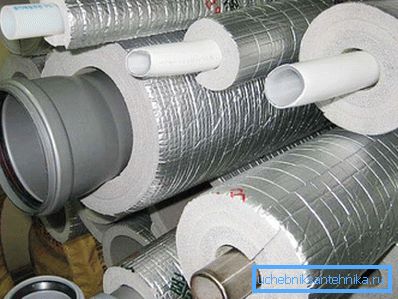
Due to the fact that the standard suburban area has a small area, you will not need kilometers of insulation for work. In this case, note that the pipes should be laid under the ground no higher than half a meter to the surface, so that the subsidence of the soil does not damage them. Of course, the more this parameter is, the better, but in this case they should be carefully insulated.
Tip: pay special attention to places in unheated rooms, this is where frost can cause trouble.
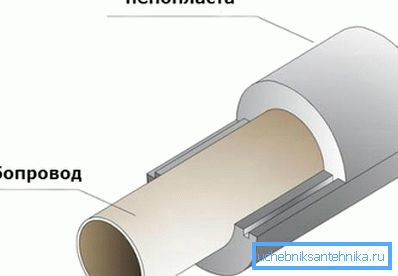
Insulation Characteristics
The time for scrap materials has passed, today manufacturers are ready to offer really good options for high-quality thermal insulation of pipes. Therefore, the most important thing is to learn how to choose them, taking into account the basic characteristics of the products and ease of installation.
The requirements are as follows:
- low thermal conductivity, good heat-saving properties;
- resistance to biological and chemical effects of the environment, as well as durability;
- the water pipe insulation must have a minimum water absorption coefficient, otherwise the level of thermal conductivity will greatly decrease;
- work at high temperatures without loss of structure and physical properties.
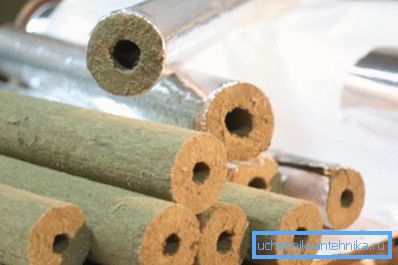
What to use
Consider how to insulate the water pipe on the street so that it does not freeze:
| Glass wool |
|
| Basalt insulation |
|
| Styrofoam |
|
| Heat insulation paint |
|
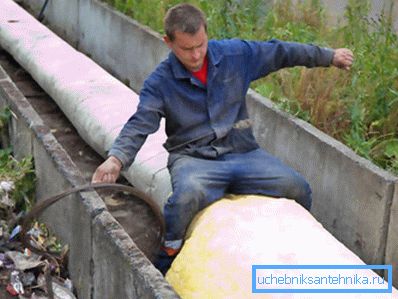
We warm the water supply under the ground
Such work is not always easy, mainly because of the soil, and has a lot of flaws.
We recommend using alternative methods of insulating water pipes underground, if there is no need to lay them at a considerable depth.
- Heating cable - heats the pipeline with the calculation of the cost of electricity about 10-20 watts per meter, outside and inside the pipe. It is necessary to turn on the system only in case of frost. In this case, it is enough to deepen the water supply by 0.5 m.
- We use air - warming occurs the listed above materials, including basalt wool and expanded polystyrene. The method consists in the fact that when a pipeline is placed in a cylindrical material, a kind of “umbrella” is created, which does not allow cold air to flow to the pipe. Plumbing as if laid inside another pipeline.
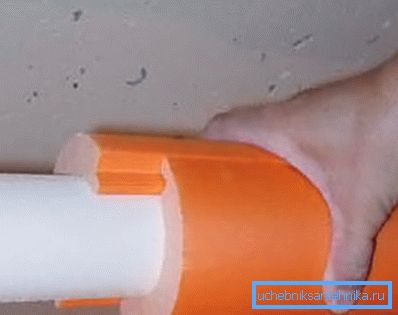
- High pressure - a receiver is installed in the system to pressurize. This option showed itself best on submersible pumps, since they have the necessary pressure for the system, approximately 5 bar.
Tip: Be sure to install a check valve after the pump.
Insulation process
The principle of operation of any insulation is the same.
Therefore, when choosing a heat-insulating material, take into account its location and water-repellent properties.
- When using glass wool, the pipe is wrapped; after its winding, it is necessary to fix it with plastic tape.. Then arrange waterproofing of roofing material or similar material.
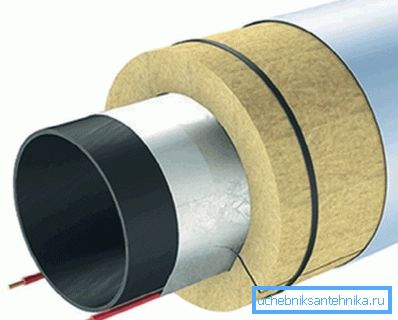
It is not recommended to use the method for underground work. In this case, you will have to use two layers - insulation and a waterproofing jacket, which takes a lot of time and requires much more, besides this will lead to a rise in the cost of the system.
Another drawback is the unevenness of the layer of insulation after the trench is filled with earth, somewhere its height will simply not be enough. This will be especially noticeable with soil tamping.
- The shell of polystyrene foam or basalt fiber is set simply and quickly with an offset of 100-200 mm relative to each other. Fastening is done with tape.
Tip: to insulate the corners, knots and turns of the system need shaped shells.
Advantage of the method:
- The water absorption of polystyrene foam per day is only 0.5-2.0% of the volume, which means that the insulation will not get wet and will not collapse under the action of moisture;
- During the backfilling of the trench, the expanded polystyrene does not wrinkle;
- does not get wet from groundwater surface.
Tip: use this technique when laying plumbing in an unheated room.
- Heating cable. The price of this method is not cheap, but with self-laying there is an opportunity to save well. There are two options for using it:
- inside the pipe - the method is rather complicated for an inexperienced home master;
- outside the pipeline before laying the insulating material.
Tip: you can buy in the distribution network ready-made kits with a heating cable installed in the pipes or with a cable channel for it.

If you carry out the insulation of water supply by heating the pipe with a cable, in this case it is enough to lay the water supply system at a depth of half a meter. From the materials you need a self-regulating cable designed for insulating pipes with a capacity of 20 W / m, waterproof insulation, adhesive tape for plumbing and foil.
Instructions works as follows:
- glue the foil tape in a spiral from 100 to 150 mm in a pipe going from the house to the well;
- lay a heating cable over it;
- glue the foil tape back on top to hold it;
- cut the insulation along and wrap around the pipe, make sure that there are no "cold bridges";
- wrap over the material plumbing tape, so you protect it from groundwater;
- additionally protect the outlet of the water supply system from under the ground and its entrance to the house, having made a heat-insulating frame of a wind and moisture-proof film, stuffing a heater inside.
Tip: You can install sensors to collect temperature information at the same time as laying the heating cable for pipes.
Conclusion
Insulation of a water pipe in our latitudes is a must-have event. Otherwise, the flow of water on the site may stop completely, which will require large expenditures to defrost the site. You can use several methods using different materials. The video in this article will provide an opportunity to find additional information on the above topic.